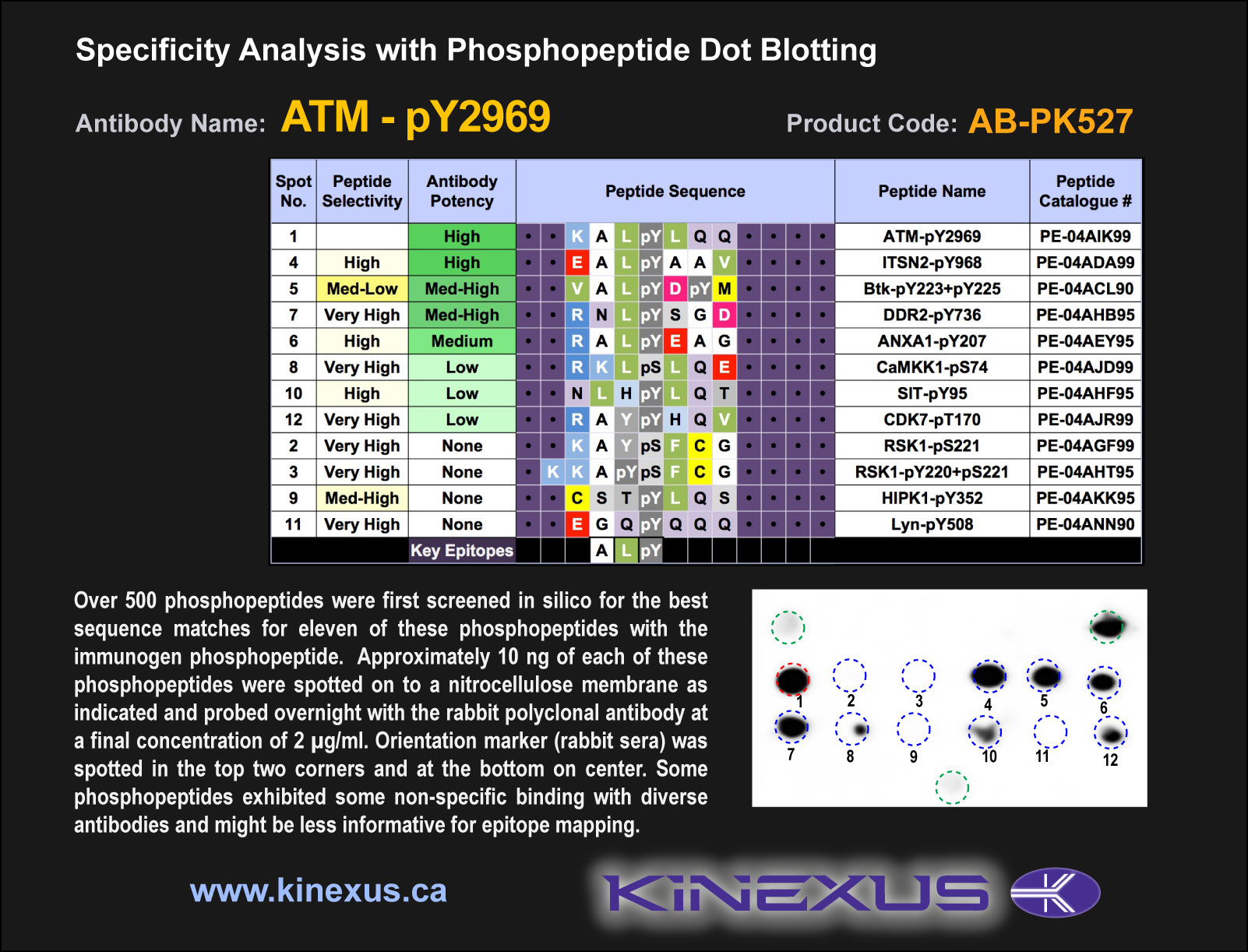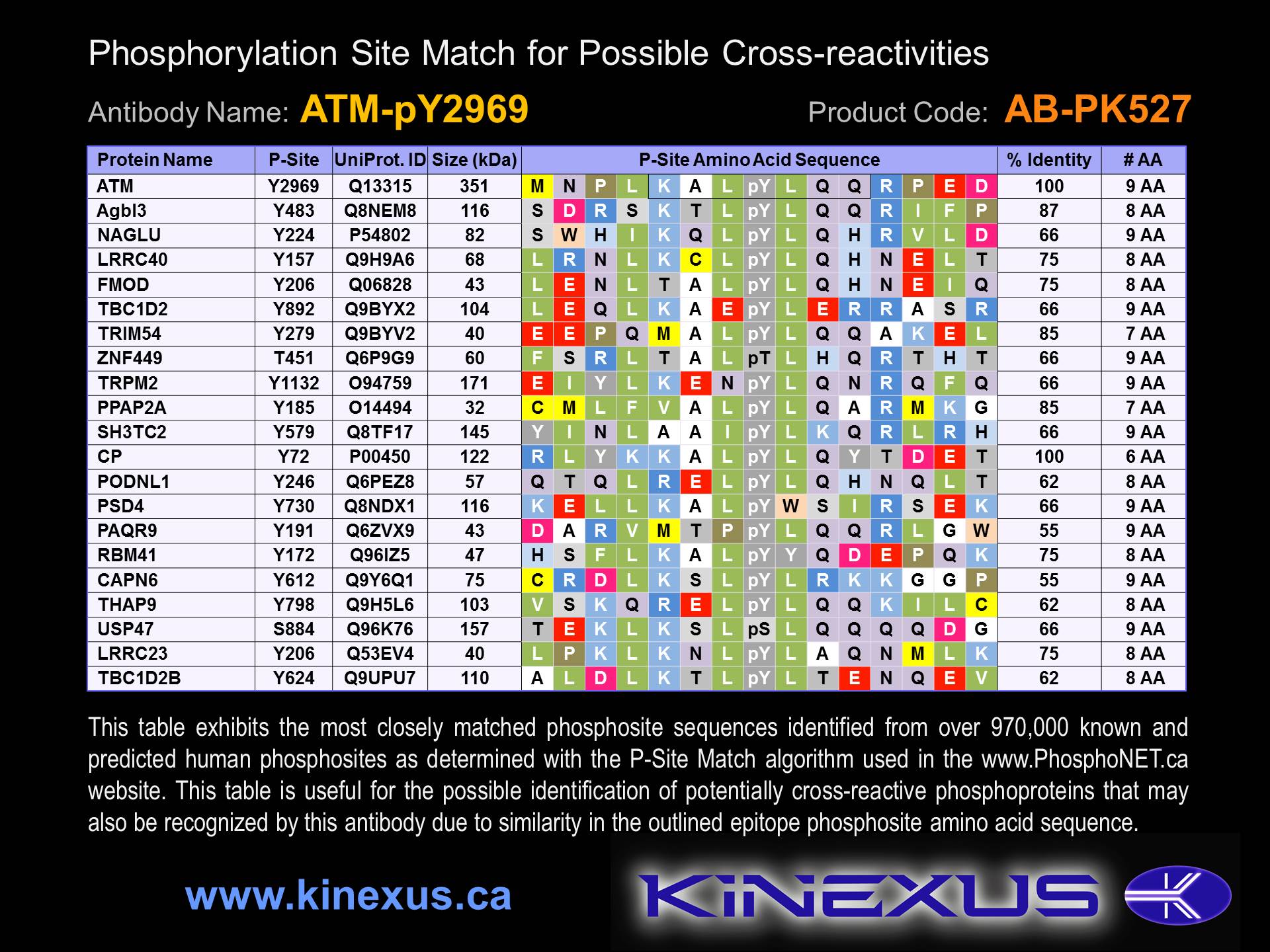Product Name: ATM-pY2969
Product Number: AB-PK527
| Size: | 25 µg | Price: | 89.00 | |
| $US |
Target Full Name: Ataxia telangiectasia mutated protein-serine kinase
Target Alias: A-T, mutated; ATA; Ataxia telangiectasia mutated; Ataxia telangiectasia mutated homolog; ATC; ATD; ATDC; Kinase ATM; TEL1; TELO1; telomere maintenance 1; MGC74674; DKFZp781A0353; MGC74674; ENSG00000149311; Telomere maintenance 1
Product Type Specific: Protein kinase phosphosite-specific antibody
Antibody Code: PK527
Antibody Target Type: Phosphosite-specific
Antibody Phosphosite: Y2969
Protein UniProt: Q13315
Protein SigNET: Q13315
Antibody Type: Polyclonal
Target Alias: A-T, mutated; ATA; Ataxia telangiectasia mutated; Ataxia telangiectasia mutated homolog; ATC; ATD; ATDC; Kinase ATM; TEL1; TELO1; telomere maintenance 1; MGC74674; DKFZp781A0353; MGC74674; ENSG00000149311; Telomere maintenance 1
Product Type Specific: Protein kinase phosphosite-specific antibody
Antibody Code: PK527
Antibody Target Type: Phosphosite-specific
Antibody Phosphosite: Y2969
Protein UniProt: Q13315
Protein SigNET: Q13315
Antibody Type: Polyclonal
Antibody Host Species: Rabbit
Antibody Immunogen Source: Human ATM sequence peptide Cat. No.: PE-04AIK99
Antibody Immunogen Sequence: KAL(pY)LQQ(bA)C
Antibody Immunogen Description: Corresponds to amino acid residues K2966 to Q2972; Near the C-terminus of the kinase. This is the major in vivo phosphorylation site in ATM.
Antibody Immunogen Source: Human ATM sequence peptide Cat. No.: PE-04AIK99
Antibody Immunogen Sequence: KAL(pY)LQQ(bA)C
Antibody Immunogen Description: Corresponds to amino acid residues K2966 to Q2972; Near the C-terminus of the kinase. This is the major in vivo phosphorylation site in ATM.
Production Method: The immunizing peptide was produced by solid phase synthesis on a multipep peptide synthesizer and purified by reverse-phase hplc chromatography. Purity was assessed by analytical hplc and the amino acid sequence confirmed by mass spectrometry analysis. This peptide was coupled to KLH prior to immunization into rabbits. New Zealand White rabbits were subcutaneously injected with KLH-coupled immunizing peptide every 4 weeks for 4 months. The sera from these animals was applied onto an agarose column to which the immunogen peptide was thio-linked. Antibody was eluted from the column with 0.1 M glycine, pH 2.5. Subsequently, the antibody solution was neutralized to pH 7.0 with saturated Tris.This antibody was also subject to negative purification over phosphotyrosine-agarose.
Antibody Modification: Unconjugated. Contact KInexus if you are interest in having the antibody biotinylated or coupled with fluorescent dyes.
Antibody Modification: Unconjugated. Contact KInexus if you are interest in having the antibody biotinylated or coupled with fluorescent dyes.
Antibody Concentration: 0.75 mg/ml
Storage Buffer: Phosphate buffered saline pH 7.4, 0.05% Thimerasol
Storage Conditions: For long term storage, keep frozen at -40°C or lower. Stock solution can be kept at +4°C for more than 3 months. Avoid repeated freeze-thaw cycles.
Product Use: Western blotting | Antibody microarray
Antibody Dilution Recommended: 2 µg/ml for immunoblotting
Antibody Species Reactivity: Human
Antibody Positive Control: The observed molecular mass of the processed target protein on SDS-PAGE gels is reported to be around 320-350 kDa.
Antibody Specificity: Very high
Storage Buffer: Phosphate buffered saline pH 7.4, 0.05% Thimerasol
Storage Conditions: For long term storage, keep frozen at -40°C or lower. Stock solution can be kept at +4°C for more than 3 months. Avoid repeated freeze-thaw cycles.
Product Use: Western blotting | Antibody microarray
Antibody Dilution Recommended: 2 µg/ml for immunoblotting
Antibody Species Reactivity: Human
Antibody Positive Control: The observed molecular mass of the processed target protein on SDS-PAGE gels is reported to be around 320-350 kDa.
Antibody Specificity: Very high
Antibody Cross Reactivity: No cross-reactive proteins detected in A431 and HeLa cells.
Related Product 1: ATM-pY2969 blocking peptide
Related Product 2: ATM pan-specific antibody (Cat. No.: AB-NK230)
Related Product 3: ATM-1 pan-specific antibody (Cat. No.: AB-NK230-2)
Related Product 4: ATM-2 pan-specific antibody (Cat. No.: AB-NK230-1)
Related Product 5: ATM-3 pan-specific antibody (Cat. No.: AB-NK230-3)
Related Product 6: ATM-pS1981 phosphosite-specific antibody (Cat. No.: AB-PK526)
Related Product 1: ATM-pY2969 blocking peptide
Related Product 2: ATM pan-specific antibody (Cat. No.: AB-NK230)
Related Product 3: ATM-1 pan-specific antibody (Cat. No.: AB-NK230-2)
Related Product 4: ATM-2 pan-specific antibody (Cat. No.: AB-NK230-1)
Related Product 5: ATM-3 pan-specific antibody (Cat. No.: AB-NK230-3)
Related Product 6: ATM-pS1981 phosphosite-specific antibody (Cat. No.: AB-PK526)
Scientific Background: ATM is a protein-serine/threonine kinase of the Atypical group and PIKK family. Phosphorylation at S1981 increases phosphotransferase activity and induces interaction with ATM, NBS1 and p53. It acts as a DNA damage sensor and appears to be a tumour suppressor protein (TSP). Cancer-related mutations in human tumours point to a loss of function of the protein kinase. The active form of the protein kinase normally acts to inhibit tumour cell proliferation. It regulates cell cycle progression checkpoints and induces DNA repair. It activates checkpoint signalling upon double strand breaks (DSBs), apoptosis and genotoxic stresses such as ionizing ultraviolet A light (UVA). It recognizes the substrate consensus sequence [S/T]-Q in many substrates. It phosphorylates and activates p53, while also inactivating the p53-inhibitor: MDM2. It phosphorylates S139 of the histone variant H2AX/H2AFX at double strand breaks (DSBs), which regulates the DNA damage response mechanism.. After the introduction of DNA breaks by the RAG complex on one immunoglobulin allele, ATM acts by mediating a repositioning of the second allele to pericentromeric heterochromatin, and prevents accessibility to the RAG complex and recombination of the second allele. It binds DNA ends, and it is part of the BRCA1- associated genome surveillance complex (BASC), which contains BRCA1, MSH2, MSH6, MLH1, ATM, BLM, PMS2 and the RAD50-MRE11-NBN protein complex. This association appears to be a dynamic process changing throughout the cell cycle and within subnuclear domains. DNA damage promotes association with RAD17. It also phosphorylates p53/TP53, FANCD2, NFKBIA, BRCA1, CTIP, nibrin (NBN), TERF1, RAD9 and DCLRE1C. It is involved in the activation of ABL1 and JNK. It may function in vesicle and/or protein transport, replication-dependent histone mRNA degradation as well as have roles in T-cell development, gonad and neurological function.
Figure 1. Epitope mapping of ATM-pY2969 antibody with similar phosphopeptides on dot blots.
Figure 2. Identification of phosphosites related to ATM-pY2969.
© Kinexus Bioinformatics Corporation 2017



